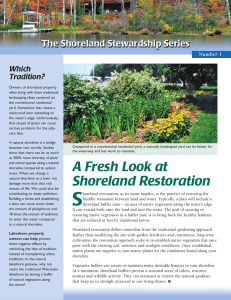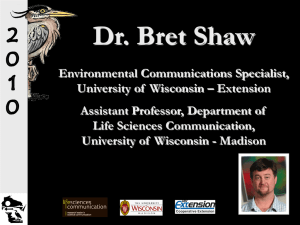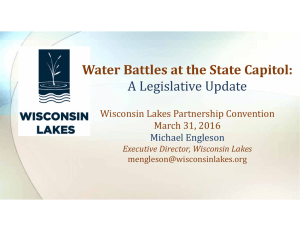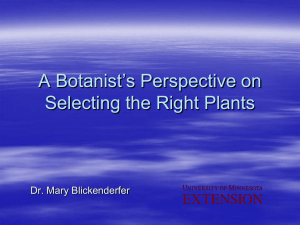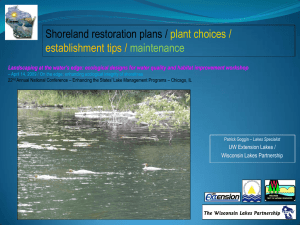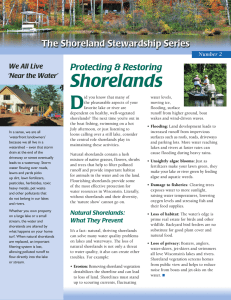The Shoreland Stewardship Series Which Tradition?
advertisement
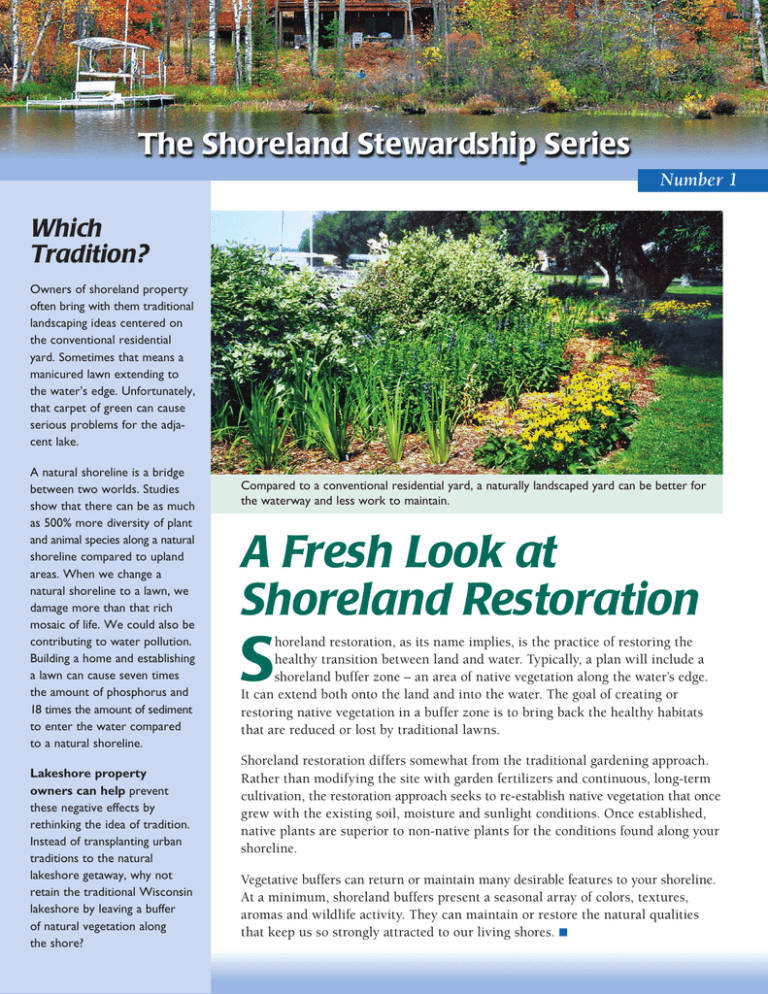
The Shoreland Stewardship Series Number 1 Which Tradition? Owners of shoreland property often bring with them traditional landscaping ideas centered on the conventional residential yard. Sometimes that means a manicured lawn extending to the water’s edge. Unfortunately, that carpet of green can cause serious problems for the adjacent lake. A natural shoreline is a bridge between two worlds. Studies show that there can be as much as 500% more diversity of plant and animal species along a natural shoreline compared to upland areas. When we change a natural shoreline to a lawn, we damage more than that rich mosaic of life. We could also be contributing to water pollution. Building a home and establishing a lawn can cause seven times the amount of phosphorus and 18 times the amount of sediment to enter the water com­pared to a natural shoreline. Lakeshore property owners can help prevent these negative effects by rethinking the idea of tradition. Instead of transplanting urban traditions to the natural lakeshore getaway, why not retain the traditional Wisconsin lake­shore by leaving a buffer of natural vegetation along the shore? Compared to a conventional residential yard, a naturally landscaped yard can be better for the waterway and less work to maintain. A Fresh Look at Shoreland Restoration S horeland restoration, as its name implies, is the practice of restoring the healthy transition between land and water. Typically, a plan will include a shoreland buffer zone – an area of native vegetation along the water’s edge. It can extend both onto the land and into the water. The goal of creating or restoring native vegetation in a buffer zone is to bring back the healthy habitats that are reduced or lost by traditional lawns. Shoreland restoration differs somewhat from the traditional gardening approach. Rather than modifying the site with garden fertilizers and continuous, long-term cultivation, the restoration approach seeks to re-establish native vegetation that once grew with the existing soil, moisture and sunlight conditions. Once established, native plants are superior to non-native plants for the conditions found along your shoreline. Vegetative buffers can return or maintain many desirable features to your shoreline. At a minimum, shoreland buffers present a seasonal array of colors, textures, aromas and wildlife activity. They can maintain or restore the natural qualities that keep us so strongly attracted to our living shores. m A Fresh Look at Shoreland Restoration What is the best way to restore shoreland to protect water and wildlife? There are a number of ways, depending on site characteristics and desires of the property owner. At right are some points to consider: No-Mow Zone Keep it in the Family Creating a buffer zone by simply not mowing along the shoreline is the easiest and least expensive method. Turf grasses will grow 12-24 inches tall before going to seed. Creating a curving edge that separates the buffer from your lawn and any pathways to the water will also give your shoreland a pleasing, natural appearance. Over time, shrubs and trees will naturally fill in and provide a more diverse plant cover. Native wildflowers, groundcovers and trees along the shore add seasonal color and diversity. Native vegetation, once established, will discourage undesirable, exotic species such as purple loosestrife from overtaking your property and can deter Canada geese from loitering on your lawn. Properly placed, native plants will frame views, muffle the noise of lake activities, protect water quality and wildlife, and restore the natural beauty of native shorelands. Reviving your shore R estoring all the functions of natural buffers takes time and effort. By far the best solution is to protect natural shorelands whenever possible. This includes leaving logs and beneficial vegetation in the water as well as protecting upland areas from mowing and other continuous disturbances that compact soil or eliminate groundcover plants, shrubs and trees. When looking to create a view of the lake, consider only selective removal of branches, trees, shrubs and groundcover. A path with an opening for your dock or swimming area may be all that you need. As times change and your use of the lake evolves, you may consider 2 letting vegetation spread and grow on its own. This option requires less maintenance and provides additional habitat benefits. In the water, aquatic vegetation can quickly recolonize sites previously cleared or disturbed, once the dis­ turbance is eliminated or reduced. •Consider docking or boating activities that allow portions of the shallow water areas to remain relatively un­disturbed. •If possible, observe what is growing in the shoreland zone at undeveloped sites near your property. These lush, natural sites provide good examples to follow when restoring your own shoreline. Much can be done to enhance the natural characteristics of areas that are currently mowed lawns. However, areas of full sun and well-established lawns often require substantially more effort to restore. In these areas, expect serious turf competi­tion. A technique called accelerated recovery can be used on these sites Roll Up Your Sleeves! Hire a Pro “Do-it-yourselfers” no longer have to wonder where to start. Many local nurseries and garden centers carry native plant stock and can recommend the best plants for your site. Local University of WisconsinExtension or Department of Natural Resources offices, and some county zoning and land conservation offices also have excellent information on how to go about the job. Shoreland restoration is a rapidly growing field among landscape professionals. Combined with better availability of native plant stocks, many landscape nurseries are now able to provide waterfront property owners with full-service shoreline restorations. Waterfront property owners can expect this service to include a detailed site analysis, a resulting site plan developed with the owner, and professionally installed (and even maintained) plantings. A well-planned landscape with natural vegetation and fiber logs along the shore can reduce soil erosion, preserve the views and allow access to the water. to jump-start natural vegetation. This approach may include controlling the existing turf and planting plants, rootstock or live stakes. For information on the process of accelerated recovery, refer to Lakescaping for Wildlife and Water Quality (listed on the back of this publication). If the area is shaded or very damp, remnants of natural vegetation are likely present and will begin to re-establish if the site is left alone. Eliminating mowing, foot traffic or other disturbance in these areas may be all that is needed to establish the process of natural recovery. Nature Abounds Perhaps the most compelling reason for restoring our shorelands to their natural splendor can be found among the living plants and animals. Although shorelands are relatively small parcels of land, they host an incredible number of species which depend on us to protect their habitat. Quite often, our attention is focused on the larger, more visible members of the lake community, such as deer and eagles. However, a complete view of the lake environment includes the smaller but more numerous members, which provide the foundation for those higher up the food chain. Tiny plants and animals called plankton provide food for insects, which in turn become food for fish, frogs and birds. The living members of our lake­shores exist in an interdependent web. Removal of one will likely affect the lives of others. Indeed, when shorelands are altered or cleared, this whole idyllic scene undergoes subtle changes that are hard to detect at first, yet the effects become devastatingly obvious as time goes by. m 3 A Fresh Look at Shoreland Restoration O ur canoe glides over the shallow waters of a bay, passing by dozens of saucer-sized nests excavated in the sandy bottom. Each nest houses bluegills guarding the eggs that hold their unborn young. The distinctive cry of an eagle fills the air and a great blue heron dips its beak into the clear water. A splash along the shore reveals a family of otters bobbing along the lakeshore in search of entertainment and a meal. The canoe continues slicing through the calm waters, past a log crowded with painted turtles competing for space to catch the morning sun. As the sun rises higher, the trilling of American toads gives way to the banjo-like strum of green frogs seeking attention from suitable mates. A gentle popping sound is evidence of fish inhaling a breakfast of insects off the water’s surface. Near the shore a cluster of delicate blue flowers emerges on stalks surrounded by the glossy leaves of pickerelweeds. Beyond this splash of color, a stand of bulrushes and cattails marks the meandering shoreline. The breeze softly rustles through the maples that overlook the bay. Make a Difference – Restore Your Shore S ights and sounds such as these reflect the spectrum of life typically found on a healthy lake or river. Here, natural shorelands provide food, clean water and habitat. Fortunately, waterfront property owners can restore or maintain many of the ecological functions of their lakeshore if a shoreland buffer zone is established or maintained. These areas not only protect our lakes, they can actually solve many problems for homeowners. As an added bonus, this rich mosaic of vegetation, water and wildlife creates a highly desired landscape that inspires our affections and increases property values. Our lakes are a place to live or vacation – for us they are a chosen landscape. For the wildlife that live there, however, our lakes are their only home. m Additional Resources Landscaping for Wildlife and Lakescaping for Wildlife and Water Quality – Minnesota Dept. of Natural Resources, 1-800-657-3757. Visit UW-Extension Lakes at: www.uwsp.edu/UWEXLakes Life on the Edge: Owning Waterfront Property – Wisconsin Lakes Partnership, (715) 346-2116. The Water’s Edge: Helping fish and wildlife on your waterfront property – UWEX Publication GWQ040 available from county UW-Extension offices or Cooperative Extension Publications 877-947-7827, and DNR publication WT-FH-428 available from local DNR service centers. The Wisconsin Lakes Partnership Rain Gardens, a Household Way to Improve Water Quality in Your Community – UWEX Publication GWQ034 available from county UW-Extension offices or Cooperative Extension Publications 877-947-7827, and DNR publication WT-731 available from local DNR service centers. Through the Looking Glass: A Field Guide to Aquatic Plants – available from UW-Extension Lakes 715/346-2116 Restore Your Shore website – www.dnr.state.mn.us/restoreyourshore Shoreland Stewardship Series: This is the third fact sheet in the shoreland stewardship series. The entire series is available from county UW-Extension offices or Cooperative Extension Publications 877-947-7827 and online at learningstore.uwex.edu, and it is available from DNR Service Centers. A publication of University of Wisconsin-Extension, Wisconsin Lakes Partnership, Wisconsin Department of Natural Resources, the Wisconsin Lakes, and The River Alliance of Wisconsin. The Wisconsin Department of Natural Resources acknowledges the Great Lakes Protection Fund and the Environmental Protection Agency’s Region V (through Section 319 of the Water Quality Act) for their involvement in the partial funding of this publication. Copyright © 2014 by the Board of Regents of the University of Wisconsin System doing business as the division of Cooperative Extension of the University of Wisconsin-Extension. All rights reserved. Send copyright inquiries to: Cooperative Extension Publishing, 432 N. Lake St., Rm. 227, Madison, WI 53706, pubs@uwex.edu. Cooperative Extension publications are subject to peer review. UWEX PUB - GWQ027 DNR PUB-FH-429 2014 Text developed by Carmen Wagner, John Haack, and Robert Korth. Photos courtesy of Jeffery Baylis, Robert Korth, J. Nehls, Robert Queen, Jeffrey J. Strobel, Carmen Wagner, and DNR file photos. Editing and design by the UW-Extension Environmental Resources Center University of Wisconsin-Extension, Cooperative Extension, in cooperation with the U.S. Department of Agriculture and Wisconsin counties, publishes this information to further the purpose of the May 8 and June 30, 1914, Acts of Congress. An EEO/AA employer, the University of Wisconsin-Extension, Cooperative Extension provides equal opportunities in employment and programming, including Title IX and ADA requirements. If you need this information in an alternative format, contact Equal Opportunity and Diversity Programs, University of Wisconsin-Extension, 432 N. Lake St., Rm. 501, Madison, WI 53706, diversity@uwex.edu, phone: (608) 262-0277, fax: (608) 262-8404, TTY: 711 Wisconsin Relay.

